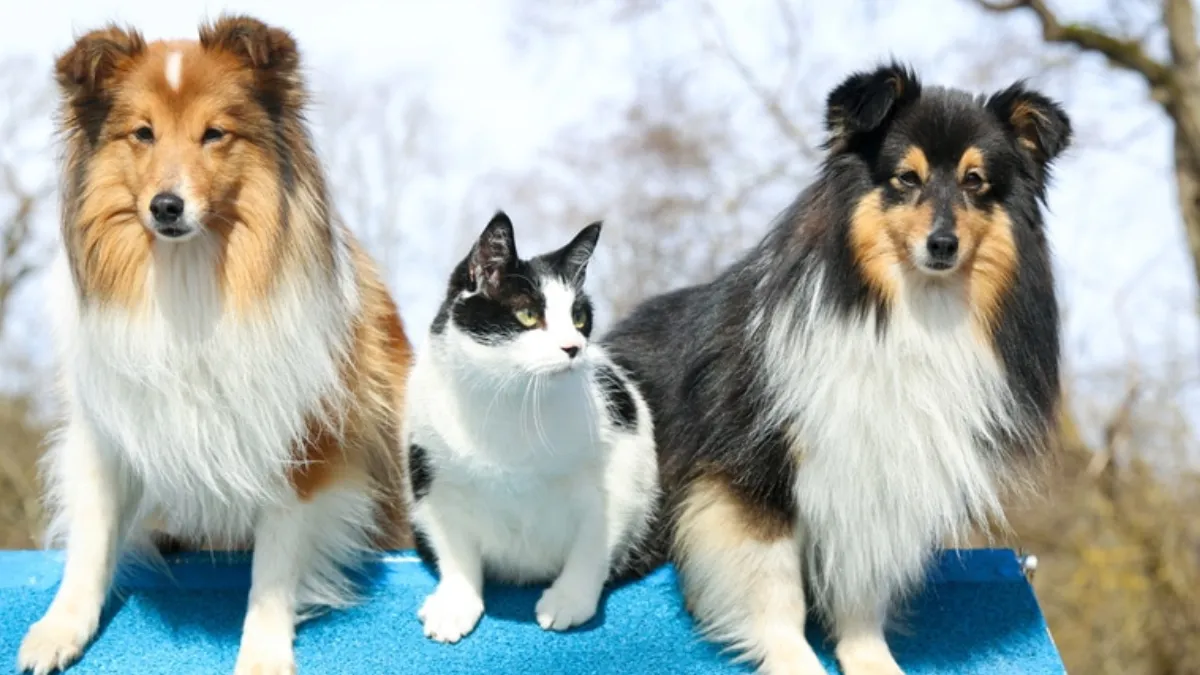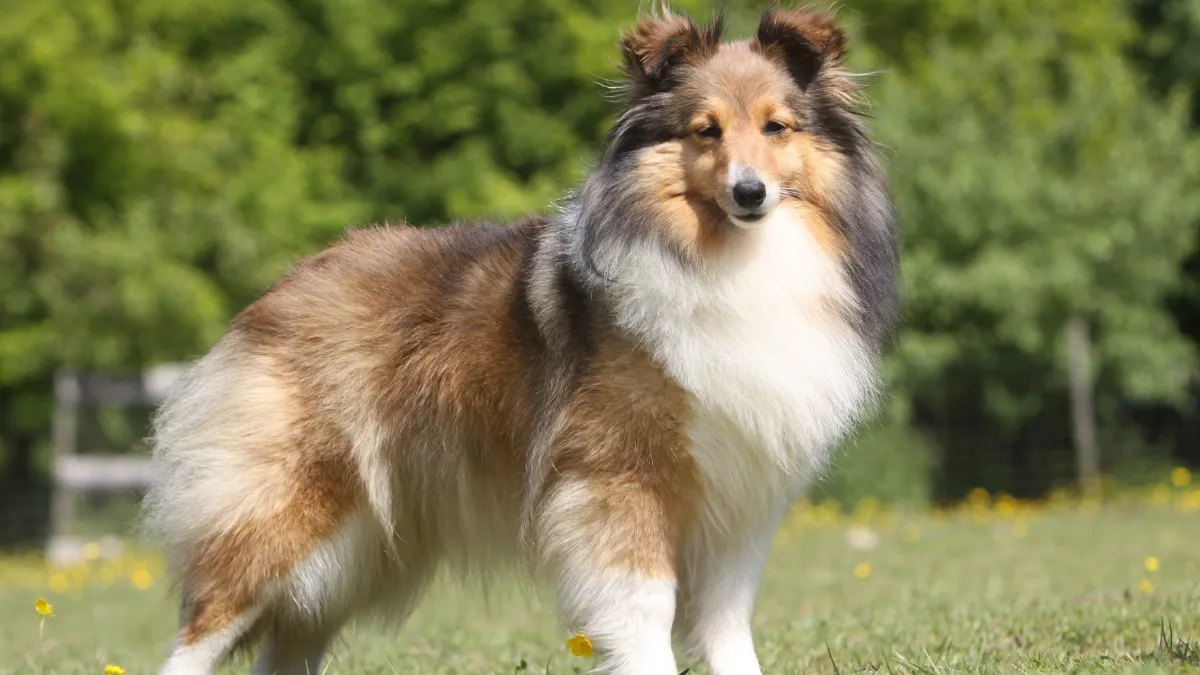Shetland Sheepdogs also referred to as Shelties, are beloved for their intelligence, loyalty, and affection. Many pet owners who have Shelties may also have cats, raising the question of whether these two pets can peacefully share a home. The answer depends on the unique personalities and behaviors of each dog and cat. Do Shetland Sheepdogs Get Along with Cats?
Shetland Sheepdogs are generally known for their friendly and social nature, which can make them well-suited to living with cats. However, it is important to note that each dog and cat is unique and may have different personalities and preferences. Some Shelties may have a strong prey drive and may be more likely to chase or harm cats, while others may be more tolerant and accepting of feline companions. Similarly, some cats may be more comfortable around dogs than others.
Shetland Sheepdog Characteristics

Physical Traits
Shetland Sheepdogs, commonly known as Shelties, are a small to medium-sized breed of dog. They typically stand between 13 and 16 inches tall and weigh between 15 and 25 pounds. Shelties have a long, dense coat that comes in a variety of colors, including sable, black, and blue merle. Their double coat requires regular grooming to prevent matting and tangling.
Behavioral Traits
Shelties are known for their high intelligence and loyalty to their owners. They are also friendly and affectionate, making them great family pets. However, they have a high energy level and require daily exercise to prevent destructive behavior. Shelties are also known for their herding instinct, which can lead to them trying to herd other pets or children in the household.
When it comes to cats, Shelties can get along well with them if they are socialized properly from a young age. However, their herding instinct may cause them to chase after cats, so it is important to supervise their interactions and train them to leave the cat alone. Overall, Shelties can make great companions for both humans and feline friends with the proper training and socialization.
Socialization and Training

Importance of Early Socialization
Shetland Sheepdogs can get along with cats if they are socialized properly from an early age. Socialization refers to the process of introducing a dog to different people, animals, and environments to help them develop social skills and confidence. Early socialization can help prevent behavioral issues such as aggression and fearfulness towards cats.
To socialize a Shetland Sheepdog with cats, it is important to expose them to cats in a controlled and positive manner. This can be done by gradually introducing the dog to a calm and friendly cat while rewarding them with treats for good behavior. It is important to supervise the interactions between the dog and cat and to intervene if necessary.
Effective Training Techniques
Training is an important aspect of helping a Shetland Sheepdog get along with cats. Positive reinforcement training techniques, such as clicker training and treats, can be effective in teaching a dog to behave appropriately around cats.
Obedience training can also help teach a Shetland Sheepdog to follow commands and behave appropriately around cats. Commands such as "leave it" and "stay" can be useful in preventing the dog from chasing or harassing the cat.
Patience and consistency are key when training a Shetland Sheepdog to get along with cats. It is important to be patient and not rush the process, as it can take time for the dog to learn and adjust. Consistency in training and enforcing rules can also help the dog understand what is expected of them.

In conclusion, with proper training and socialization, Shetland Sheepdogs can get along with cats. It is important to use positive reinforcement training techniques, be patient and consistent, and supervise interactions between the dog and cat.
Compatibility with Cats
Shetland Sheepdogs, also known as Shelties, are a playful and energetic breed that can make great companions for cats. However, several factors can affect their compatibility.
Factors Affecting Compatibility
One factor that can affect the compatibility between shelters and cats is their herding instincts. Shelties were originally bred to herd sheep, and as such, they may try to herd cats as well. This can lead to chasing and nipping behavior, which can be stressful for cats. However, with proper training and socialization, this behavior can be minimized.
Another factor is the temperament of the individual Sheltie. Some shelters may be more tolerant of cats than others. It is important to observe the behavior of the Sheltie around cats before introducing them to each other.
Introducing Shelties to Cats
When introducing a Sheltie to a cat, it is important to do so slowly and carefully. It is recommended to keep the Sheltie on a leash or in a crate during the initial introduction. This allows both animals to become familiar with each other's scent and behavior without any physical contact.

Once they have become comfortable with each other's presence, they can be allowed to interact under close supervision. It is important to reward positive behavior and discourage any negative behavior.
Socializing the Sheltie from a young age can also help to increase their compatibility with cats. Exposing them to different animals, including cats, can help them to develop positive associations and reduce any herding instincts.
In conclusion, Shelsheltersies can get along with cats with proper training, socialization, and supervision. It is important to consider their herding instincts and individual temperament when introducing them to cats.
Health and Care
Common Health Issues
Shetland Sheepdogs are generally healthy dogs. However, like all breeds, they are susceptible to certain health issues. One of the most common health issues in Shelties is Collie Eye Anomaly (CEA), which is a genetic condition that affects the eyes. It can range from mild to severe and can cause blindness in some cases. It is important to get your Sheltie from a reputable breeder who has tested their breeding dogs for CEA.
Another health issue that can affect Shelties is Canine Hip Dysplasia (CHD), which is a genetic condition that affects the hips. This condition can cause pain and difficulty walking and can lead to arthritis. It is important to keep your Sheltie at a healthy weight and to provide them with regular exercise to help prevent CHD.
Grooming and Exercise Needs
Shetland Sheepdogs have a thick, double coat that requires regular grooming to prevent matting and tangling. They should be brushed at least once a week and more frequently during shedding season. In addition to regular grooming, Shelties also require daily exercise to keep them healthy and happy. They are an active breed and enjoy activities such as walking, hiking, and playing fetch.

In terms of diet, shelters require a balanced diet that is appropriate for their age, size, and activity level. It is important to feed them high-quality dog food and to monitor their calorie intake to prevent obesity. Mental stimulation is also important for Shelties, as they are an intelligent breed that enjoys learning and problem-solving. Providing them with puzzle toys and training sessions can help keep them mentally stimulated.
Sheltie Breed Information
Breed History
Shetland Sheepdogs, also known as Shelties, are a breed of herding dogs that originated in the Shetland Islands of Scotland. They were developed by crossing the local Spitz-type dogs with Collies, which were brought to the islands by English shepherds. The breed was first recognized by the American Kennel Club (AKC) in 1911 and has since gained popularity as a companion dog.
Breed Varieties
Shelties come in a variety of colors, including sable, black, and blue merle. They are a small to medium-sized breed, typically weighing between 14 and 27 pounds. Shelties are known for their thick, double coats that require regular grooming to prevent matting.
Shelties are closely related to Collies and share many of the same characteristics, including their herding instincts and intelligence. They are also known for their loyalty and affectionate nature, making them popular as family pets.
The breed is recognized by several kennel clubs, including the AKC and the English Kennel Club. The American Shetland Sheepdog Association is the breed's national club in the United States and provides information and resources for Sheltie owners and enthusiasts.

Overall, Shelties are a well-loved breed that makes great companions for those who enjoy an active lifestyle and are willing to provide them with the attention and exercise they need. They are often compared to Border Collies in terms of their intelligence and herding abilities but are more suited to life as a family pet rather than a working dog.
Choosing a Sheltie
When it comes to choosing a Shetland Sheepdog, it is important to do your research and find a reputable breeder or rescue organization. Here are some things to consider when making your decision.
Finding a Reputable Breeder
When looking for a breeder, it is important to find one who is reputable and responsible. A good breeder will prioritize the health and well-being of their dogs and will be knowledgeable about the breed.
Here are some things to look for in a reputable breeder:
- They should be willing to answer any questions you have about the breed and their breeding practices.
- They should provide health clearances for their breeding dogs, which can include hip and eye exams.
- They should allow you to meet the puppies and their parents in person.
- They should provide a written contract that outlines the terms of the sale and any health guarantees.
Adoption from Rescue Organizations
If you are considering adopting a Sheltie from a rescue organization, there are many benefits to doing so. Adopting from a rescue organization can give a dog a second chance at a happy life and can also be a rewarding experience for the adopter.
Here are some things to consider when adopting from a rescue organization:
- You should research the organization thoroughly to ensure they are reputable and responsible.
- You should be prepared for the potential challenges that come with adopting a dog that may have had a difficult past.
- You should be willing to provide the time and resources necessary to help the dog adjust to their new home.

Whether you choose to adopt or purchase a Sheltie, it is important to do your research and find a responsible breeder or rescue organization. By doing so, you can ensure that you are getting a healthy and happy dog that will make a wonderful addition to your family.
Conclusion:
In conclusion, exploring the question "Do Shetland Sheepdogs Get Along with Cats?" reveals that the compatibility between these two species largely depends on individual temperament, early socialization, and the dynamics of the specific household. While some Shetland Sheepdogs may form strong bonds with cats and coexist peacefully, others may display more predatory behaviors towards them.
Understanding and managing the introduction process between a Sheltie and a cat is crucial for fostering a harmonious relationship. Slow and supervised introductions, along with positive reinforcement training, can help establish trust and prevent potential conflicts.
Additionally, providing separate spaces and resources for both the Shetland Sheepdog and the cat, such as separate feeding areas and resting spots, can reduce competition and territorial disputes.
Ultimately, successful cohabitation between Shetland Sheepdogs and cats is achievable with patience, careful supervision, and proactive management. While there are no guarantees of perfect harmony, many households enjoy the companionship of both Shelties and feline friends, enriching their lives with the unique dynamics and interactions between these two beloved species.




